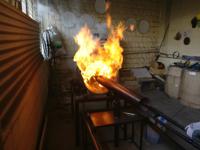Whisky Barrel Char Level
Contents

American oak casks are toasted and charred before being used to mature Bourbon whiskey. Toasting not only breaks down the structure of the oak and allows the spirit to penetrate more easily, but also creates new flavour compounds. This is due to the structure of the wood itself. Oak is made up of cellulose, hemicellulose and lignin. The former gives the oak its strength, the other two begin to break down when heated, forming flavour compounds that are soluble in ethanol and impart desirable aromas to wines and spirits. The process is also used to create STR casks.
Why are bourbon barrels charred?
By law only virgin American oak casks can be used to mature Bourbon whiskey. During the production of the bourbon barrel, the barrel is usually first treated with around 95 degrees hot steam and then for about 15 minutes with between 230-260 degrees heat (toasted). Finally, the barrel is charred with an open flame (charred).
An initial heat treatment enables the oak staves can be brought into the desired barrel shape. Thereafter the oak wood is activated by the high temperatures and the charring, which has a positive effect on the taste of the whiskey. At its core, heat treating accomplishes three different things:
- Splitting of wood polymers
- Thermal degradation of unwanted flavours
- Creation of a charcoal surface
How does toasting and charring affect the whiskey?
Due to the effect of heat (toasting), various components in the oak wood such as hemicellulose, lignin, tannins and lactones are broken down and can be absorbed into the whiskey during maturation. Without the pre-treatment of the oak wood, the bourbon would not get its distinctive taste.
How do the individual wood components affect the whiskey?
- Hemicellulose: The heat breaks down into various sugars and caramelizes on the surface of the wood - responsible for notes of caramel or toffee
- Lignin: Is broken down into various flavour-active components - in particular vanilla or spicy and smoky notes get into the whiskey
- Tannins: Provide a dry, astringent mouthfeel and play an important role in whiskey colour. They also remove sulphurous notes from the whiskey and make the whiskey more storable. Greater cask charring results in a weaker reaction between whiskey and tannins
- Lactones: Are crucial to the woody flavours in whiskey. The more the barrel is charred (barrel char level), the lower the influence of the lactones
By charring the oak barrels, the surface of the barrel staves are prepared for the maturation of the whiskey and, depending on the barrel char level, a more or less thick layer of charcoal is created inside the barrel.
The charcoal filters the whiskey during maturation, removing unwanted flavours. These include, for example, unsaturated fatty acids (including linoleic acid) and aldehydes, which can add unwanted metallic notes or aromas of mushrooms or cardboard to the whiskey. The Lincoln County Process for Tennessee Whiskey is also used for its filtering effect.
In addition, the oak wood breaks open when charred. This allows the whiskey to penetrate deeper layers of wood during maturation and extract more flavour from the oak. The intensity of the charring is indicated for bourbon whiskeys with the barrel char level.
Levels of barrel char
A total of four different barrel char levels are usually distinguished, each of which differs in the exposure time of the flame. The following bourbon char levels are common:
- Char Level #1: 15 seconds
- Char Level #2: 30 seconds
- Char Level #3: 35 seconds
- Char Level #4: 55 seconds
Char Level #4 is also known as Alligator Char, as the oak staves begins to crack and peel in a rough, shiny pattern reminiscent of an alligator’s skin.
FAQs
What is barrel char level?
Barrel char level refers to the specific amount of time distillers char the barrels. Barrel Charring in Bourbon Production Charring changes the oak to produce the best reaction between the whiskey and wood as it ages. Char level 1 is 15 seconds while Char level 4 is 55 seconds.
Why do they char the inside of whiskey barrels?
This char layer serves to remove any impurities or unwanted flavors from the wood, which can improve the taste of the whiskey. In addition the char layer helps to create a seal between the wood and the whiskey, which can prevent the whiskey from interacting with the wood too much and picking up unwanted flavors. Finally, the charring process can help to caramelize the sugars in the wood, which can add some sweet, spicy, and smoky flavors to the whiskey. Overall, charring the inside of whiskey barrels is an important step in the production of many types of whiskey, and helps to give the finished product its unique flavor and character.
Are all whiskey barrels charred?
Yes, while we've heard rumours for years of uncharred casks we know of no experiments with uncharred casks.
Previous
Next

